Commercial Banks and Interest Rate Dynamics in Tajikistan: Review
VerifiedAdded on 2021/02/19
|63
|26743
|72
Thesis and Dissertation
AI Summary
This dissertation chapter presents a comprehensive literature review on the dynamics of interest rates within Tajikistan's commercial banking sector. It explores various themes, including the current conditions of interest rates, the theoretical underpinnings of their fluctuations, and the impact of interest rate liberalization. The review analyzes the role of the National Bank of Tajikistan, the influence of discount rates, and the relative factors driving interest rate changes. It also examines the benefits and challenges associated with WTO accession in the banking sector and compares Tajikistan's interest rate policies with those of neighboring countries. The chapter synthesizes research from multiple sources, including Mogilevskii and Asadov (2018), Mehrotra and Yetman (2015), and others, to provide a nuanced understanding of the economic implications of interest rate policies in Tajikistan. The analysis covers the impact on businesses, farmers, and the broader economy, considering both the positive and negative consequences of fluctuating interest rates and their influence on economic growth, inflation, and investment.
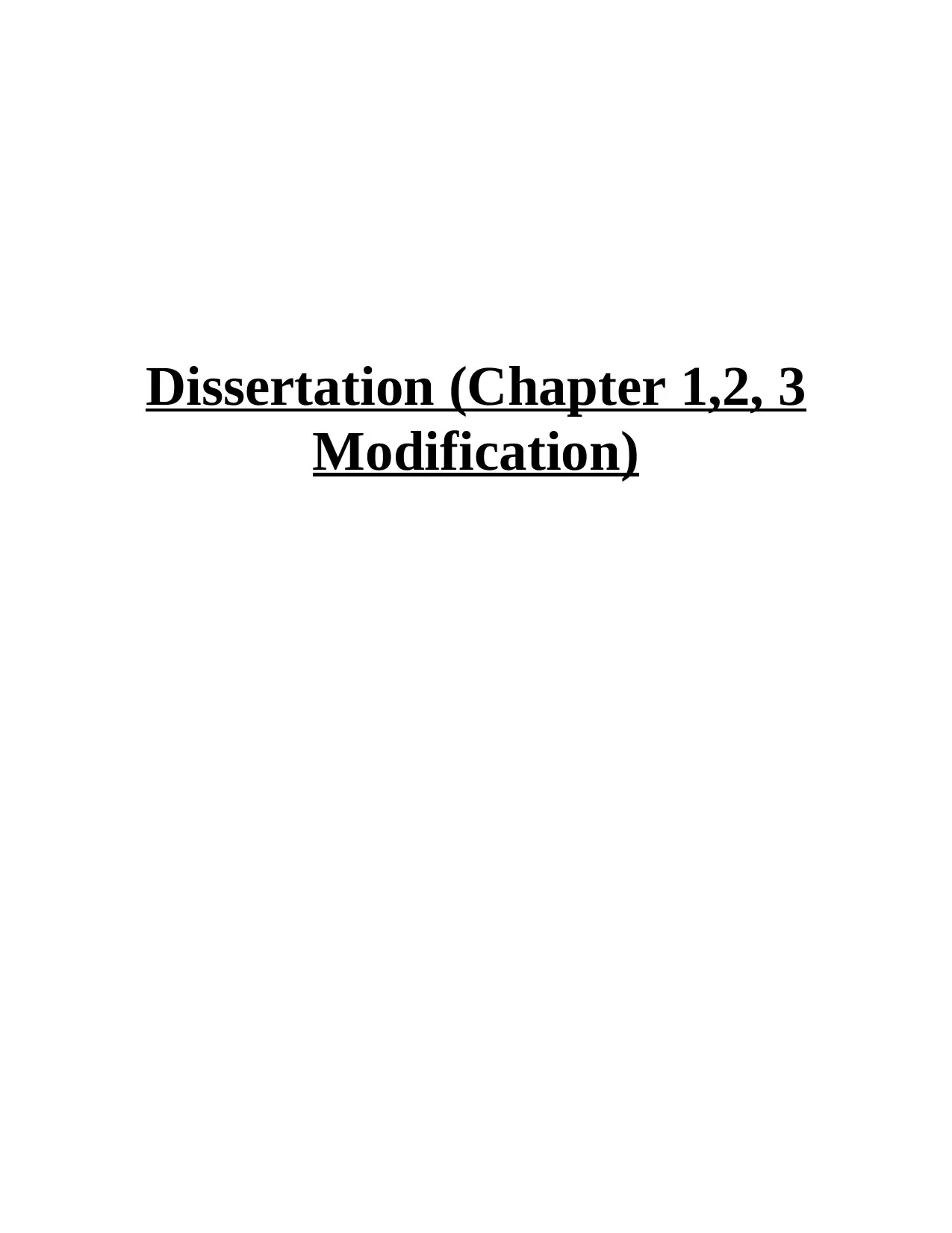
Dissertation (Chapter 1,2, 3
Modification)
Modification)
Paraphrase This Document
Need a fresh take? Get an instant paraphrase of this document with our AI Paraphraser
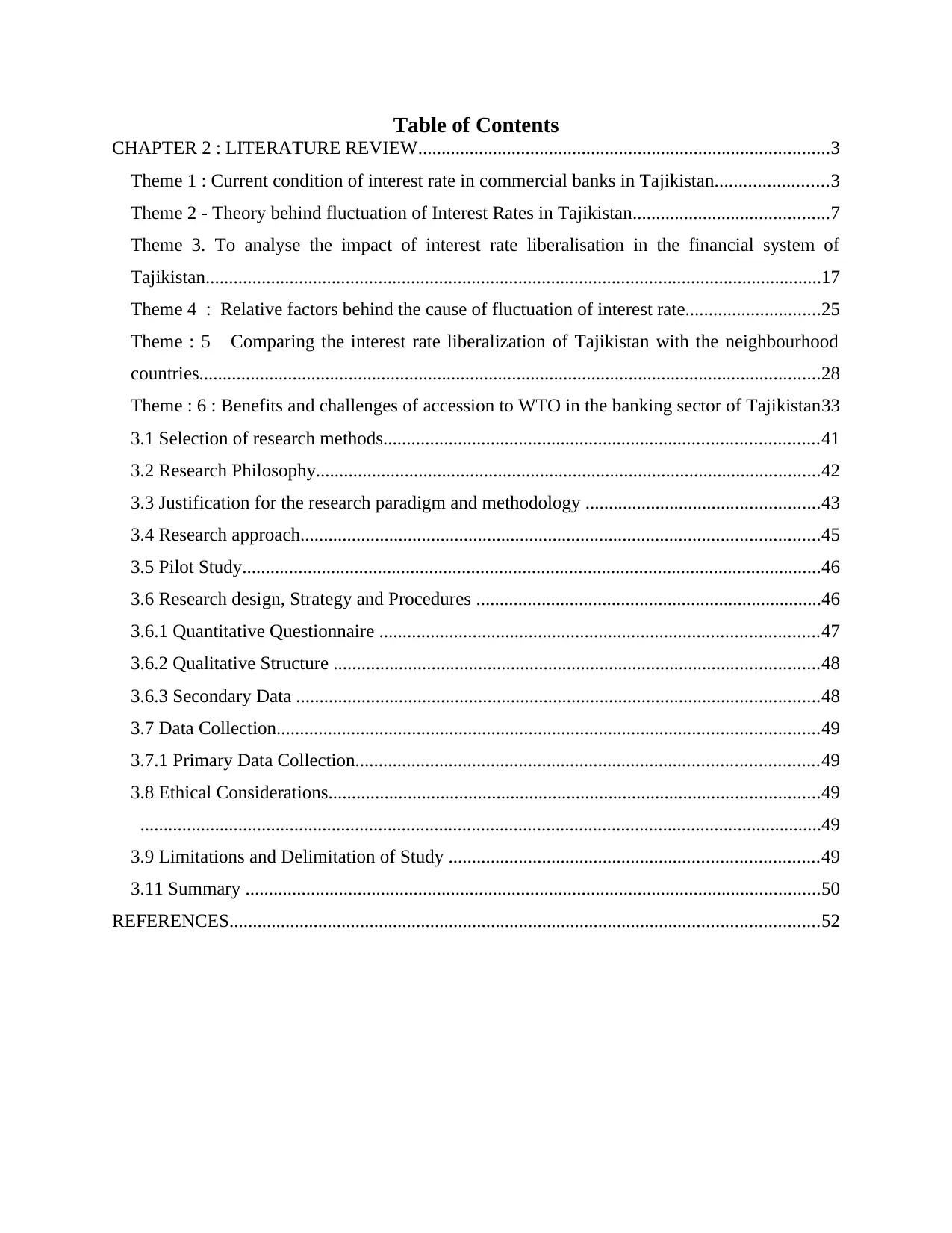
Table of Contents
CHAPTER 2 : LITERATURE REVIEW........................................................................................3
Theme 1 : Current condition of interest rate in commercial banks in Tajikistan........................3
Theme 2 - Theory behind fluctuation of Interest Rates in Tajikistan..........................................7
Theme 3. To analyse the impact of interest rate liberalisation in the financial system of
Tajikistan....................................................................................................................................17
Theme 4 : Relative factors behind the cause of fluctuation of interest rate.............................25
Theme : 5 Comparing the interest rate liberalization of Tajikistan with the neighbourhood
countries.....................................................................................................................................28
Theme : 6 : Benefits and challenges of accession to WTO in the banking sector of Tajikistan33
3.1 Selection of research methods.............................................................................................41
3.2 Research Philosophy............................................................................................................42
3.3 Justification for the research paradigm and methodology ..................................................43
3.4 Research approach...............................................................................................................45
3.5 Pilot Study............................................................................................................................46
3.6 Research design, Strategy and Procedures ..........................................................................46
3.6.1 Quantitative Questionnaire ..............................................................................................47
3.6.2 Qualitative Structure ........................................................................................................48
3.6.3 Secondary Data ................................................................................................................48
3.7 Data Collection....................................................................................................................49
3.7.1 Primary Data Collection...................................................................................................49
3.8 Ethical Considerations.........................................................................................................49
..................................................................................................................................................49
3.9 Limitations and Delimitation of Study ...............................................................................49
3.11 Summary ...........................................................................................................................50
REFERENCES..............................................................................................................................52
CHAPTER 2 : LITERATURE REVIEW........................................................................................3
Theme 1 : Current condition of interest rate in commercial banks in Tajikistan........................3
Theme 2 - Theory behind fluctuation of Interest Rates in Tajikistan..........................................7
Theme 3. To analyse the impact of interest rate liberalisation in the financial system of
Tajikistan....................................................................................................................................17
Theme 4 : Relative factors behind the cause of fluctuation of interest rate.............................25
Theme : 5 Comparing the interest rate liberalization of Tajikistan with the neighbourhood
countries.....................................................................................................................................28
Theme : 6 : Benefits and challenges of accession to WTO in the banking sector of Tajikistan33
3.1 Selection of research methods.............................................................................................41
3.2 Research Philosophy............................................................................................................42
3.3 Justification for the research paradigm and methodology ..................................................43
3.4 Research approach...............................................................................................................45
3.5 Pilot Study............................................................................................................................46
3.6 Research design, Strategy and Procedures ..........................................................................46
3.6.1 Quantitative Questionnaire ..............................................................................................47
3.6.2 Qualitative Structure ........................................................................................................48
3.6.3 Secondary Data ................................................................................................................48
3.7 Data Collection....................................................................................................................49
3.7.1 Primary Data Collection...................................................................................................49
3.8 Ethical Considerations.........................................................................................................49
..................................................................................................................................................49
3.9 Limitations and Delimitation of Study ...............................................................................49
3.11 Summary ...........................................................................................................................50
REFERENCES..............................................................................................................................52
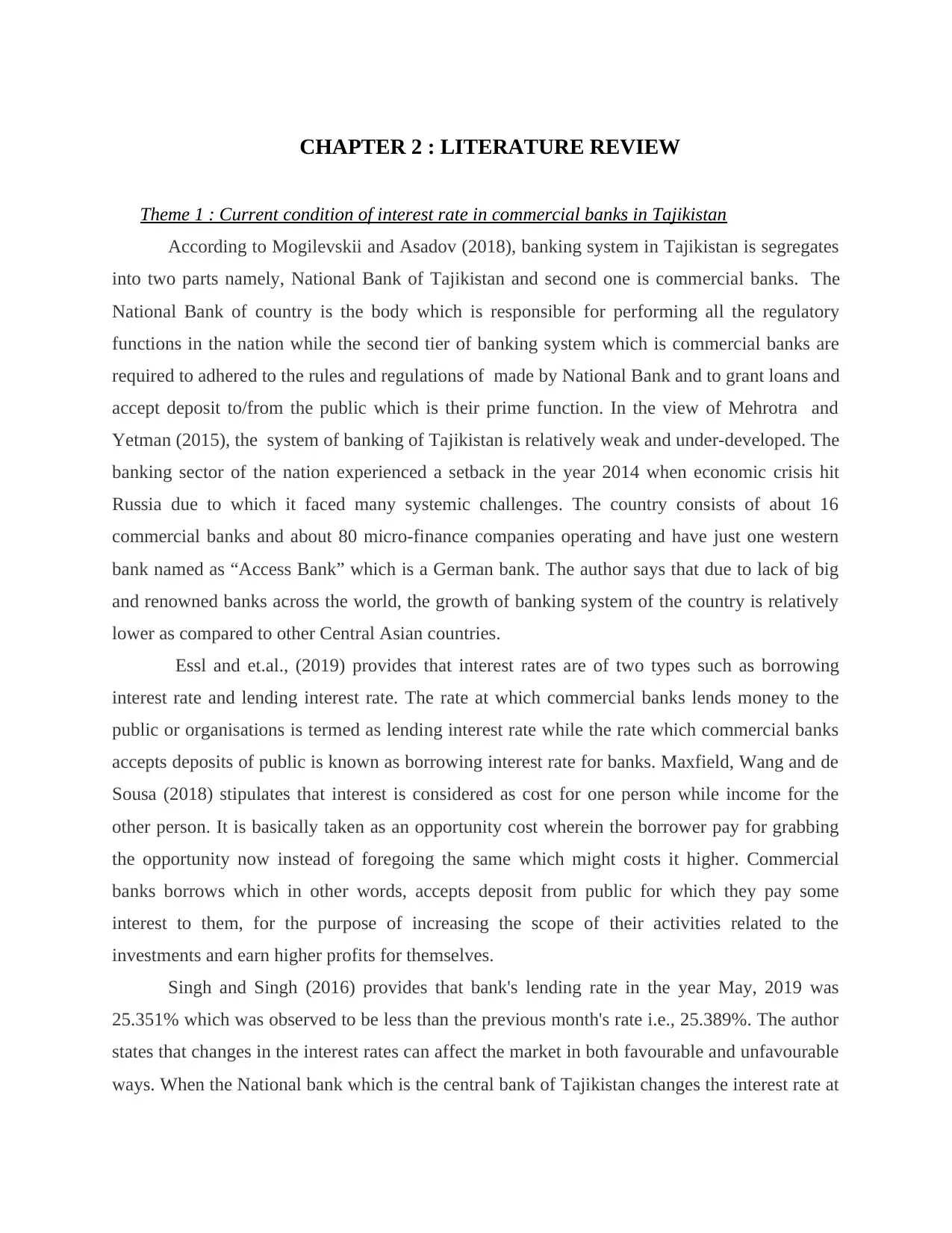
CHAPTER 2 : LITERATURE REVIEW
Theme 1 : Current condition of interest rate in commercial banks in Tajikistan
According to Mogilevskii and Asadov (2018), banking system in Tajikistan is segregates
into two parts namely, National Bank of Tajikistan and second one is commercial banks. The
National Bank of country is the body which is responsible for performing all the regulatory
functions in the nation while the second tier of banking system which is commercial banks are
required to adhered to the rules and regulations of made by National Bank and to grant loans and
accept deposit to/from the public which is their prime function. In the view of Mehrotra and
Yetman (2015), the system of banking of Tajikistan is relatively weak and under-developed. The
banking sector of the nation experienced a setback in the year 2014 when economic crisis hit
Russia due to which it faced many systemic challenges. The country consists of about 16
commercial banks and about 80 micro-finance companies operating and have just one western
bank named as “Access Bank” which is a German bank. The author says that due to lack of big
and renowned banks across the world, the growth of banking system of the country is relatively
lower as compared to other Central Asian countries.
Essl and et.al., (2019) provides that interest rates are of two types such as borrowing
interest rate and lending interest rate. The rate at which commercial banks lends money to the
public or organisations is termed as lending interest rate while the rate which commercial banks
accepts deposits of public is known as borrowing interest rate for banks. Maxfield, Wang and de
Sousa (2018) stipulates that interest is considered as cost for one person while income for the
other person. It is basically taken as an opportunity cost wherein the borrower pay for grabbing
the opportunity now instead of foregoing the same which might costs it higher. Commercial
banks borrows which in other words, accepts deposit from public for which they pay some
interest to them, for the purpose of increasing the scope of their activities related to the
investments and earn higher profits for themselves.
Singh and Singh (2016) provides that bank's lending rate in the year May, 2019 was
25.351% which was observed to be less than the previous month's rate i.e., 25.389%. The author
states that changes in the interest rates can affect the market in both favourable and unfavourable
ways. When the National bank which is the central bank of Tajikistan changes the interest rate at
Theme 1 : Current condition of interest rate in commercial banks in Tajikistan
According to Mogilevskii and Asadov (2018), banking system in Tajikistan is segregates
into two parts namely, National Bank of Tajikistan and second one is commercial banks. The
National Bank of country is the body which is responsible for performing all the regulatory
functions in the nation while the second tier of banking system which is commercial banks are
required to adhered to the rules and regulations of made by National Bank and to grant loans and
accept deposit to/from the public which is their prime function. In the view of Mehrotra and
Yetman (2015), the system of banking of Tajikistan is relatively weak and under-developed. The
banking sector of the nation experienced a setback in the year 2014 when economic crisis hit
Russia due to which it faced many systemic challenges. The country consists of about 16
commercial banks and about 80 micro-finance companies operating and have just one western
bank named as “Access Bank” which is a German bank. The author says that due to lack of big
and renowned banks across the world, the growth of banking system of the country is relatively
lower as compared to other Central Asian countries.
Essl and et.al., (2019) provides that interest rates are of two types such as borrowing
interest rate and lending interest rate. The rate at which commercial banks lends money to the
public or organisations is termed as lending interest rate while the rate which commercial banks
accepts deposits of public is known as borrowing interest rate for banks. Maxfield, Wang and de
Sousa (2018) stipulates that interest is considered as cost for one person while income for the
other person. It is basically taken as an opportunity cost wherein the borrower pay for grabbing
the opportunity now instead of foregoing the same which might costs it higher. Commercial
banks borrows which in other words, accepts deposit from public for which they pay some
interest to them, for the purpose of increasing the scope of their activities related to the
investments and earn higher profits for themselves.
Singh and Singh (2016) provides that bank's lending rate in the year May, 2019 was
25.351% which was observed to be less than the previous month's rate i.e., 25.389%. The author
states that changes in the interest rates can affect the market in both favourable and unfavourable
ways. When the National bank which is the central bank of Tajikistan changes the interest rate at
⊘ This is a preview!⊘
Do you want full access?
Subscribe today to unlock all pages.

Trusted by 1+ million students worldwide
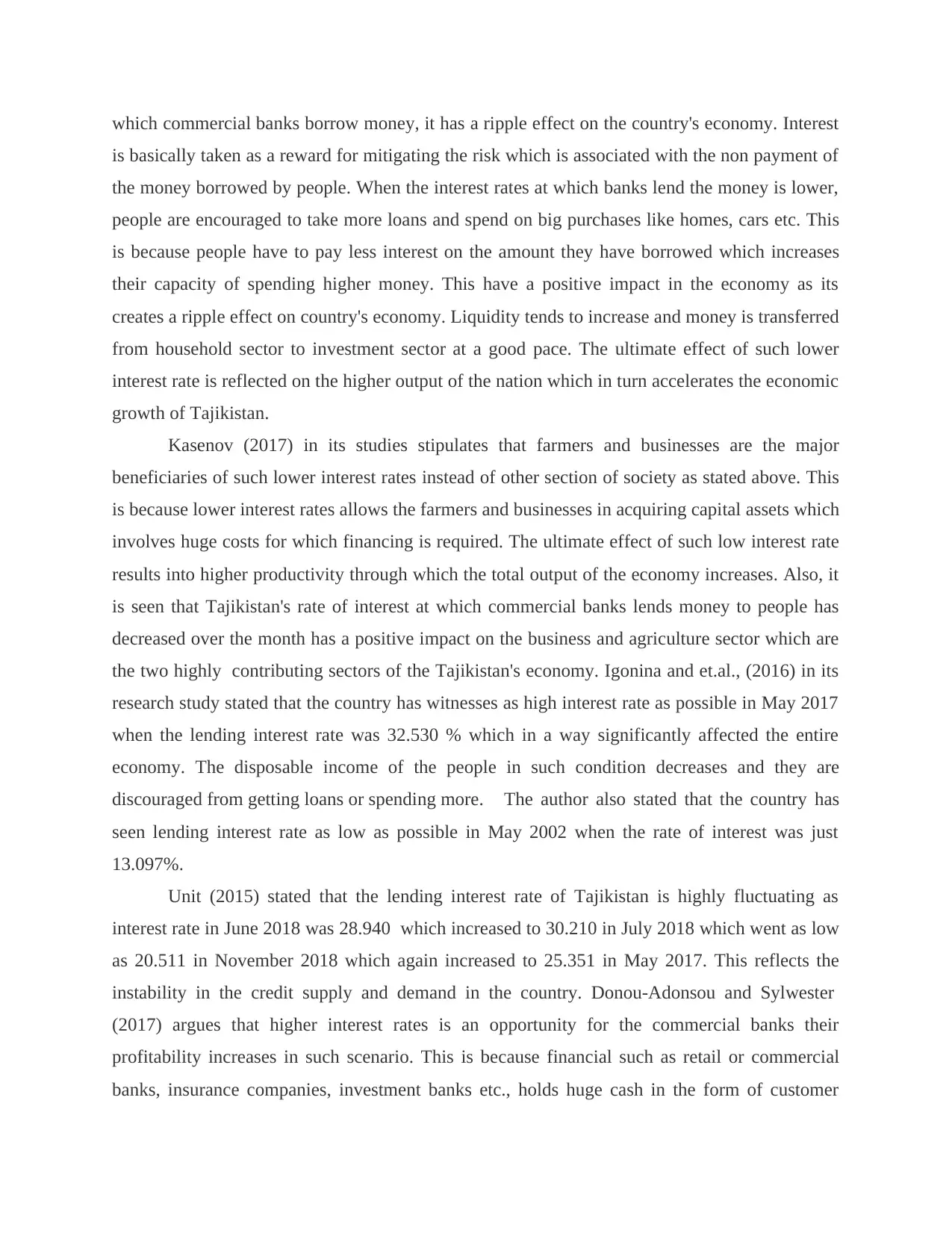
which commercial banks borrow money, it has a ripple effect on the country's economy. Interest
is basically taken as a reward for mitigating the risk which is associated with the non payment of
the money borrowed by people. When the interest rates at which banks lend the money is lower,
people are encouraged to take more loans and spend on big purchases like homes, cars etc. This
is because people have to pay less interest on the amount they have borrowed which increases
their capacity of spending higher money. This have a positive impact in the economy as its
creates a ripple effect on country's economy. Liquidity tends to increase and money is transferred
from household sector to investment sector at a good pace. The ultimate effect of such lower
interest rate is reflected on the higher output of the nation which in turn accelerates the economic
growth of Tajikistan.
Kasenov (2017) in its studies stipulates that farmers and businesses are the major
beneficiaries of such lower interest rates instead of other section of society as stated above. This
is because lower interest rates allows the farmers and businesses in acquiring capital assets which
involves huge costs for which financing is required. The ultimate effect of such low interest rate
results into higher productivity through which the total output of the economy increases. Also, it
is seen that Tajikistan's rate of interest at which commercial banks lends money to people has
decreased over the month has a positive impact on the business and agriculture sector which are
the two highly contributing sectors of the Tajikistan's economy. Igonina and et.al., (2016) in its
research study stated that the country has witnesses as high interest rate as possible in May 2017
when the lending interest rate was 32.530 % which in a way significantly affected the entire
economy. The disposable income of the people in such condition decreases and they are
discouraged from getting loans or spending more. The author also stated that the country has
seen lending interest rate as low as possible in May 2002 when the rate of interest was just
13.097%.
Unit (2015) stated that the lending interest rate of Tajikistan is highly fluctuating as
interest rate in June 2018 was 28.940 which increased to 30.210 in July 2018 which went as low
as 20.511 in November 2018 which again increased to 25.351 in May 2017. This reflects the
instability in the credit supply and demand in the country. Donou-Adonsou and Sylwester
(2017) argues that higher interest rates is an opportunity for the commercial banks their
profitability increases in such scenario. This is because financial such as retail or commercial
banks, insurance companies, investment banks etc., holds huge cash in the form of customer
is basically taken as a reward for mitigating the risk which is associated with the non payment of
the money borrowed by people. When the interest rates at which banks lend the money is lower,
people are encouraged to take more loans and spend on big purchases like homes, cars etc. This
is because people have to pay less interest on the amount they have borrowed which increases
their capacity of spending higher money. This have a positive impact in the economy as its
creates a ripple effect on country's economy. Liquidity tends to increase and money is transferred
from household sector to investment sector at a good pace. The ultimate effect of such lower
interest rate is reflected on the higher output of the nation which in turn accelerates the economic
growth of Tajikistan.
Kasenov (2017) in its studies stipulates that farmers and businesses are the major
beneficiaries of such lower interest rates instead of other section of society as stated above. This
is because lower interest rates allows the farmers and businesses in acquiring capital assets which
involves huge costs for which financing is required. The ultimate effect of such low interest rate
results into higher productivity through which the total output of the economy increases. Also, it
is seen that Tajikistan's rate of interest at which commercial banks lends money to people has
decreased over the month has a positive impact on the business and agriculture sector which are
the two highly contributing sectors of the Tajikistan's economy. Igonina and et.al., (2016) in its
research study stated that the country has witnesses as high interest rate as possible in May 2017
when the lending interest rate was 32.530 % which in a way significantly affected the entire
economy. The disposable income of the people in such condition decreases and they are
discouraged from getting loans or spending more. The author also stated that the country has
seen lending interest rate as low as possible in May 2002 when the rate of interest was just
13.097%.
Unit (2015) stated that the lending interest rate of Tajikistan is highly fluctuating as
interest rate in June 2018 was 28.940 which increased to 30.210 in July 2018 which went as low
as 20.511 in November 2018 which again increased to 25.351 in May 2017. This reflects the
instability in the credit supply and demand in the country. Donou-Adonsou and Sylwester
(2017) argues that higher interest rates is an opportunity for the commercial banks their
profitability increases in such scenario. This is because financial such as retail or commercial
banks, insurance companies, investment banks etc., holds huge cash in the form of customer
Paraphrase This Document
Need a fresh take? Get an instant paraphrase of this document with our AI Paraphraser
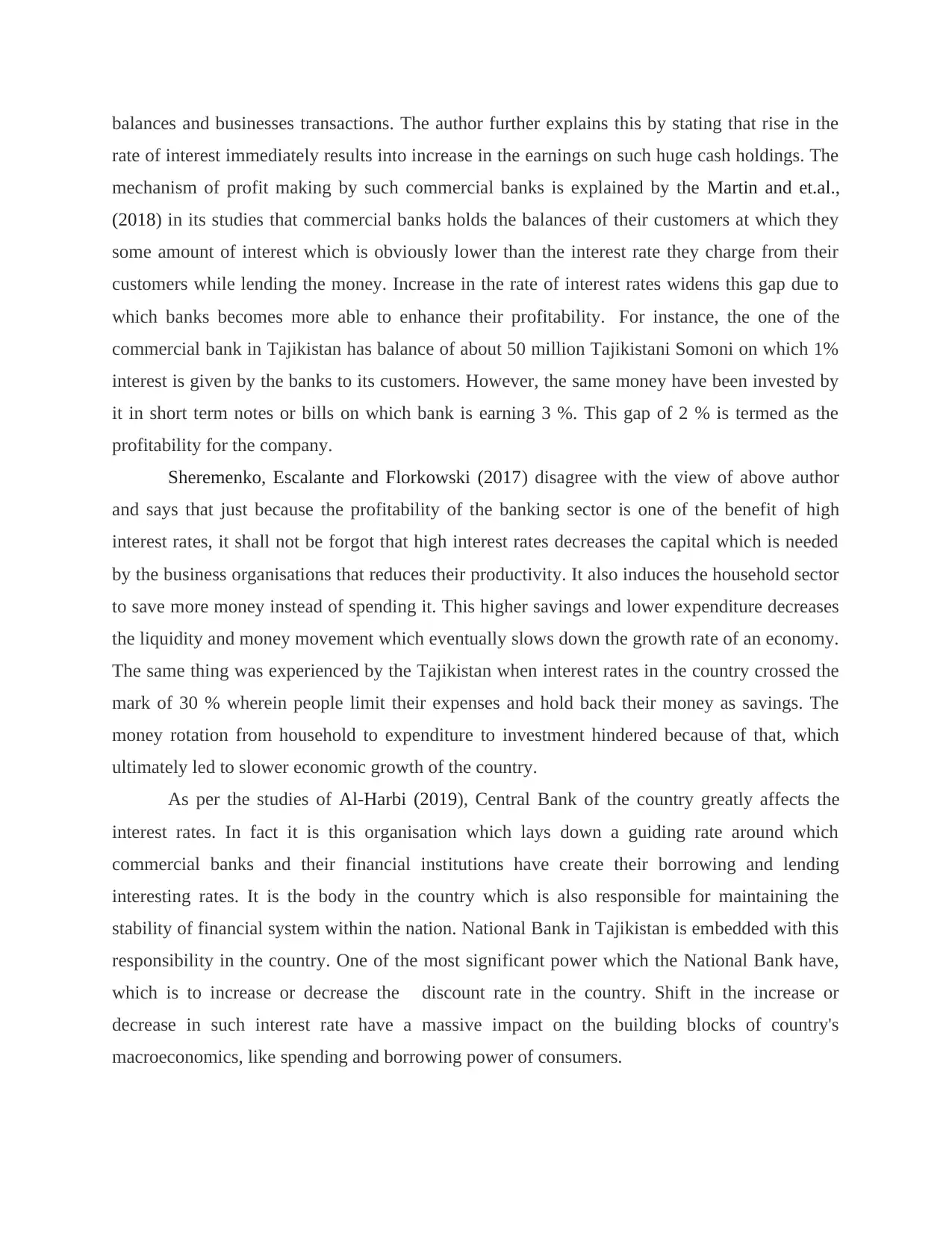
balances and businesses transactions. The author further explains this by stating that rise in the
rate of interest immediately results into increase in the earnings on such huge cash holdings. The
mechanism of profit making by such commercial banks is explained by the Martin and et.al.,
(2018) in its studies that commercial banks holds the balances of their customers at which they
some amount of interest which is obviously lower than the interest rate they charge from their
customers while lending the money. Increase in the rate of interest rates widens this gap due to
which banks becomes more able to enhance their profitability. For instance, the one of the
commercial bank in Tajikistan has balance of about 50 million Tajikistani Somoni on which 1%
interest is given by the banks to its customers. However, the same money have been invested by
it in short term notes or bills on which bank is earning 3 %. This gap of 2 % is termed as the
profitability for the company.
Sheremenko, Escalante and Florkowski (2017) disagree with the view of above author
and says that just because the profitability of the banking sector is one of the benefit of high
interest rates, it shall not be forgot that high interest rates decreases the capital which is needed
by the business organisations that reduces their productivity. It also induces the household sector
to save more money instead of spending it. This higher savings and lower expenditure decreases
the liquidity and money movement which eventually slows down the growth rate of an economy.
The same thing was experienced by the Tajikistan when interest rates in the country crossed the
mark of 30 % wherein people limit their expenses and hold back their money as savings. The
money rotation from household to expenditure to investment hindered because of that, which
ultimately led to slower economic growth of the country.
As per the studies of Al-Harbi (2019), Central Bank of the country greatly affects the
interest rates. In fact it is this organisation which lays down a guiding rate around which
commercial banks and their financial institutions have create their borrowing and lending
interesting rates. It is the body in the country which is also responsible for maintaining the
stability of financial system within the nation. National Bank in Tajikistan is embedded with this
responsibility in the country. One of the most significant power which the National Bank have,
which is to increase or decrease the discount rate in the country. Shift in the increase or
decrease in such interest rate have a massive impact on the building blocks of country's
macroeconomics, like spending and borrowing power of consumers.
rate of interest immediately results into increase in the earnings on such huge cash holdings. The
mechanism of profit making by such commercial banks is explained by the Martin and et.al.,
(2018) in its studies that commercial banks holds the balances of their customers at which they
some amount of interest which is obviously lower than the interest rate they charge from their
customers while lending the money. Increase in the rate of interest rates widens this gap due to
which banks becomes more able to enhance their profitability. For instance, the one of the
commercial bank in Tajikistan has balance of about 50 million Tajikistani Somoni on which 1%
interest is given by the banks to its customers. However, the same money have been invested by
it in short term notes or bills on which bank is earning 3 %. This gap of 2 % is termed as the
profitability for the company.
Sheremenko, Escalante and Florkowski (2017) disagree with the view of above author
and says that just because the profitability of the banking sector is one of the benefit of high
interest rates, it shall not be forgot that high interest rates decreases the capital which is needed
by the business organisations that reduces their productivity. It also induces the household sector
to save more money instead of spending it. This higher savings and lower expenditure decreases
the liquidity and money movement which eventually slows down the growth rate of an economy.
The same thing was experienced by the Tajikistan when interest rates in the country crossed the
mark of 30 % wherein people limit their expenses and hold back their money as savings. The
money rotation from household to expenditure to investment hindered because of that, which
ultimately led to slower economic growth of the country.
As per the studies of Al-Harbi (2019), Central Bank of the country greatly affects the
interest rates. In fact it is this organisation which lays down a guiding rate around which
commercial banks and their financial institutions have create their borrowing and lending
interesting rates. It is the body in the country which is also responsible for maintaining the
stability of financial system within the nation. National Bank in Tajikistan is embedded with this
responsibility in the country. One of the most significant power which the National Bank have,
which is to increase or decrease the discount rate in the country. Shift in the increase or
decrease in such interest rate have a massive impact on the building blocks of country's
macroeconomics, like spending and borrowing power of consumers.
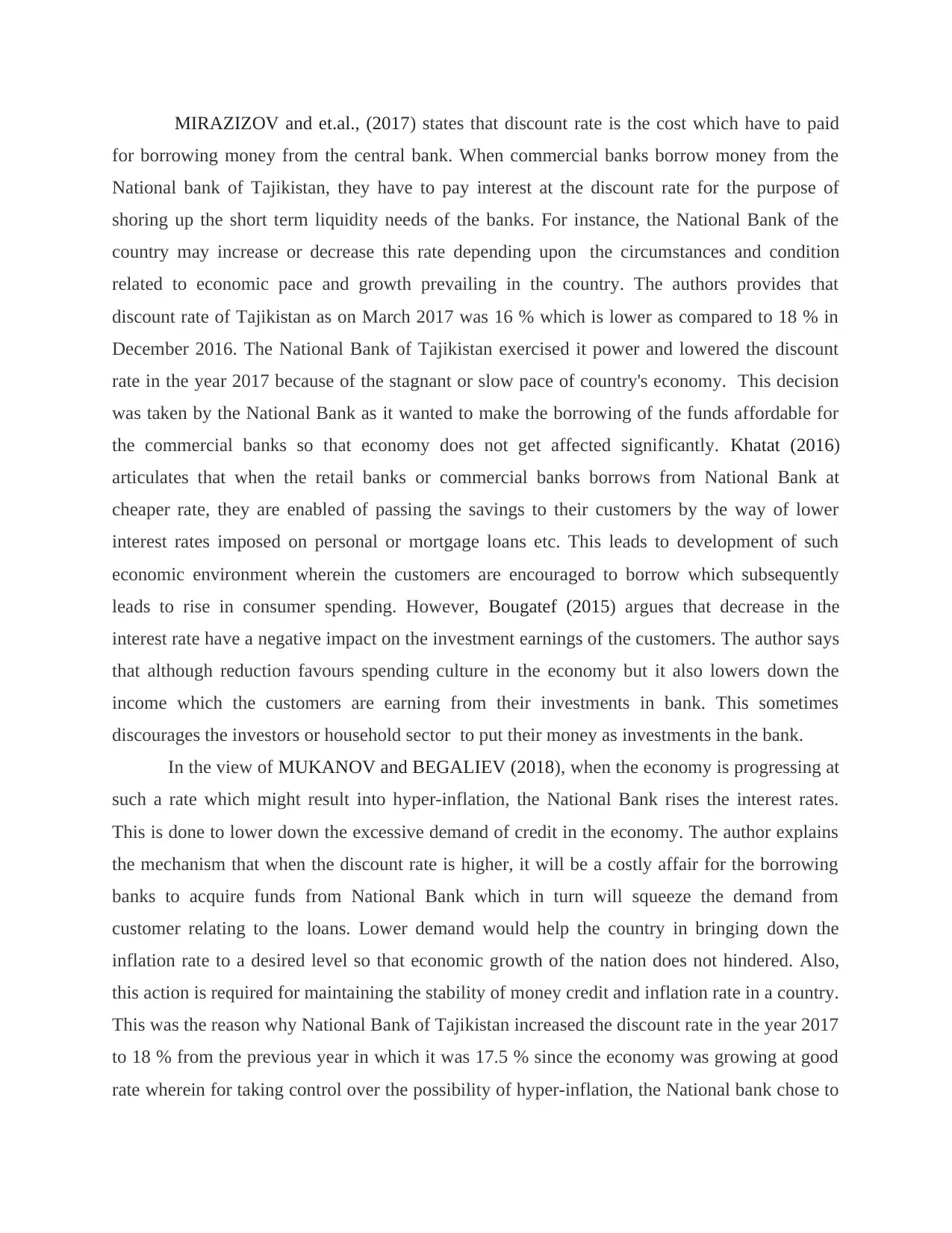
MIRAZIZOV and et.al., (2017) states that discount rate is the cost which have to paid
for borrowing money from the central bank. When commercial banks borrow money from the
National bank of Tajikistan, they have to pay interest at the discount rate for the purpose of
shoring up the short term liquidity needs of the banks. For instance, the National Bank of the
country may increase or decrease this rate depending upon the circumstances and condition
related to economic pace and growth prevailing in the country. The authors provides that
discount rate of Tajikistan as on March 2017 was 16 % which is lower as compared to 18 % in
December 2016. The National Bank of Tajikistan exercised it power and lowered the discount
rate in the year 2017 because of the stagnant or slow pace of country's economy. This decision
was taken by the National Bank as it wanted to make the borrowing of the funds affordable for
the commercial banks so that economy does not get affected significantly. Khatat (2016)
articulates that when the retail banks or commercial banks borrows from National Bank at
cheaper rate, they are enabled of passing the savings to their customers by the way of lower
interest rates imposed on personal or mortgage loans etc. This leads to development of such
economic environment wherein the customers are encouraged to borrow which subsequently
leads to rise in consumer spending. However, Bougatef (2015) argues that decrease in the
interest rate have a negative impact on the investment earnings of the customers. The author says
that although reduction favours spending culture in the economy but it also lowers down the
income which the customers are earning from their investments in bank. This sometimes
discourages the investors or household sector to put their money as investments in the bank.
In the view of MUKANOV and BEGALIEV (2018), when the economy is progressing at
such a rate which might result into hyper-inflation, the National Bank rises the interest rates.
This is done to lower down the excessive demand of credit in the economy. The author explains
the mechanism that when the discount rate is higher, it will be a costly affair for the borrowing
banks to acquire funds from National Bank which in turn will squeeze the demand from
customer relating to the loans. Lower demand would help the country in bringing down the
inflation rate to a desired level so that economic growth of the nation does not hindered. Also,
this action is required for maintaining the stability of money credit and inflation rate in a country.
This was the reason why National Bank of Tajikistan increased the discount rate in the year 2017
to 18 % from the previous year in which it was 17.5 % since the economy was growing at good
rate wherein for taking control over the possibility of hyper-inflation, the National bank chose to
for borrowing money from the central bank. When commercial banks borrow money from the
National bank of Tajikistan, they have to pay interest at the discount rate for the purpose of
shoring up the short term liquidity needs of the banks. For instance, the National Bank of the
country may increase or decrease this rate depending upon the circumstances and condition
related to economic pace and growth prevailing in the country. The authors provides that
discount rate of Tajikistan as on March 2017 was 16 % which is lower as compared to 18 % in
December 2016. The National Bank of Tajikistan exercised it power and lowered the discount
rate in the year 2017 because of the stagnant or slow pace of country's economy. This decision
was taken by the National Bank as it wanted to make the borrowing of the funds affordable for
the commercial banks so that economy does not get affected significantly. Khatat (2016)
articulates that when the retail banks or commercial banks borrows from National Bank at
cheaper rate, they are enabled of passing the savings to their customers by the way of lower
interest rates imposed on personal or mortgage loans etc. This leads to development of such
economic environment wherein the customers are encouraged to borrow which subsequently
leads to rise in consumer spending. However, Bougatef (2015) argues that decrease in the
interest rate have a negative impact on the investment earnings of the customers. The author says
that although reduction favours spending culture in the economy but it also lowers down the
income which the customers are earning from their investments in bank. This sometimes
discourages the investors or household sector to put their money as investments in the bank.
In the view of MUKANOV and BEGALIEV (2018), when the economy is progressing at
such a rate which might result into hyper-inflation, the National Bank rises the interest rates.
This is done to lower down the excessive demand of credit in the economy. The author explains
the mechanism that when the discount rate is higher, it will be a costly affair for the borrowing
banks to acquire funds from National Bank which in turn will squeeze the demand from
customer relating to the loans. Lower demand would help the country in bringing down the
inflation rate to a desired level so that economic growth of the nation does not hindered. Also,
this action is required for maintaining the stability of money credit and inflation rate in a country.
This was the reason why National Bank of Tajikistan increased the discount rate in the year 2017
to 18 % from the previous year in which it was 17.5 % since the economy was growing at good
rate wherein for taking control over the possibility of hyper-inflation, the National bank chose to
⊘ This is a preview!⊘
Do you want full access?
Subscribe today to unlock all pages.

Trusted by 1+ million students worldwide
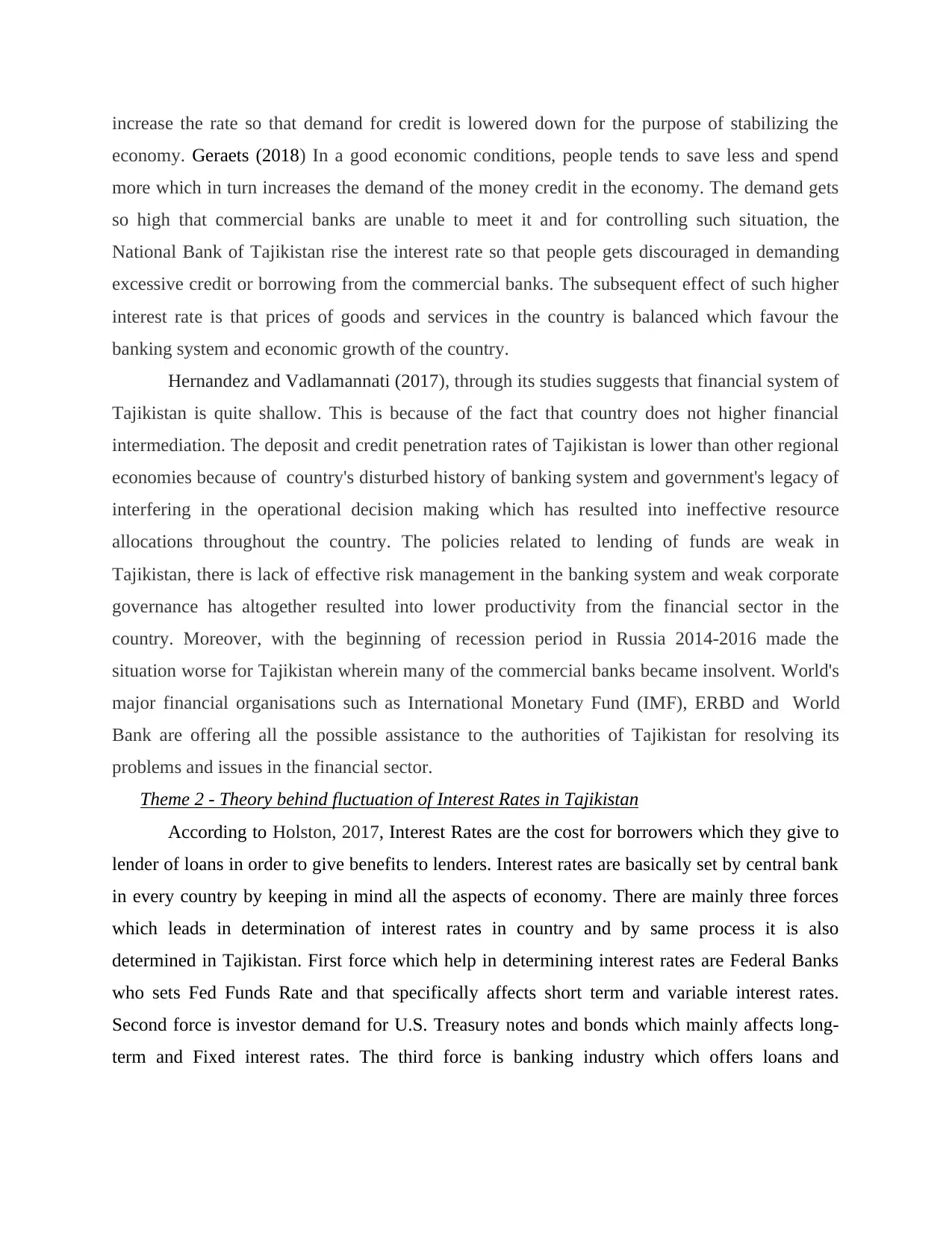
increase the rate so that demand for credit is lowered down for the purpose of stabilizing the
economy. Geraets (2018) In a good economic conditions, people tends to save less and spend
more which in turn increases the demand of the money credit in the economy. The demand gets
so high that commercial banks are unable to meet it and for controlling such situation, the
National Bank of Tajikistan rise the interest rate so that people gets discouraged in demanding
excessive credit or borrowing from the commercial banks. The subsequent effect of such higher
interest rate is that prices of goods and services in the country is balanced which favour the
banking system and economic growth of the country.
Hernandez and Vadlamannati (2017), through its studies suggests that financial system of
Tajikistan is quite shallow. This is because of the fact that country does not higher financial
intermediation. The deposit and credit penetration rates of Tajikistan is lower than other regional
economies because of country's disturbed history of banking system and government's legacy of
interfering in the operational decision making which has resulted into ineffective resource
allocations throughout the country. The policies related to lending of funds are weak in
Tajikistan, there is lack of effective risk management in the banking system and weak corporate
governance has altogether resulted into lower productivity from the financial sector in the
country. Moreover, with the beginning of recession period in Russia 2014-2016 made the
situation worse for Tajikistan wherein many of the commercial banks became insolvent. World's
major financial organisations such as International Monetary Fund (IMF), ERBD and World
Bank are offering all the possible assistance to the authorities of Tajikistan for resolving its
problems and issues in the financial sector.
Theme 2 - Theory behind fluctuation of Interest Rates in Tajikistan
According to Holston, 2017, Interest Rates are the cost for borrowers which they give to
lender of loans in order to give benefits to lenders. Interest rates are basically set by central bank
in every country by keeping in mind all the aspects of economy. There are mainly three forces
which leads in determination of interest rates in country and by same process it is also
determined in Tajikistan. First force which help in determining interest rates are Federal Banks
who sets Fed Funds Rate and that specifically affects short term and variable interest rates.
Second force is investor demand for U.S. Treasury notes and bonds which mainly affects long-
term and Fixed interest rates. The third force is banking industry which offers loans and
economy. Geraets (2018) In a good economic conditions, people tends to save less and spend
more which in turn increases the demand of the money credit in the economy. The demand gets
so high that commercial banks are unable to meet it and for controlling such situation, the
National Bank of Tajikistan rise the interest rate so that people gets discouraged in demanding
excessive credit or borrowing from the commercial banks. The subsequent effect of such higher
interest rate is that prices of goods and services in the country is balanced which favour the
banking system and economic growth of the country.
Hernandez and Vadlamannati (2017), through its studies suggests that financial system of
Tajikistan is quite shallow. This is because of the fact that country does not higher financial
intermediation. The deposit and credit penetration rates of Tajikistan is lower than other regional
economies because of country's disturbed history of banking system and government's legacy of
interfering in the operational decision making which has resulted into ineffective resource
allocations throughout the country. The policies related to lending of funds are weak in
Tajikistan, there is lack of effective risk management in the banking system and weak corporate
governance has altogether resulted into lower productivity from the financial sector in the
country. Moreover, with the beginning of recession period in Russia 2014-2016 made the
situation worse for Tajikistan wherein many of the commercial banks became insolvent. World's
major financial organisations such as International Monetary Fund (IMF), ERBD and World
Bank are offering all the possible assistance to the authorities of Tajikistan for resolving its
problems and issues in the financial sector.
Theme 2 - Theory behind fluctuation of Interest Rates in Tajikistan
According to Holston, 2017, Interest Rates are the cost for borrowers which they give to
lender of loans in order to give benefits to lenders. Interest rates are basically set by central bank
in every country by keeping in mind all the aspects of economy. There are mainly three forces
which leads in determination of interest rates in country and by same process it is also
determined in Tajikistan. First force which help in determining interest rates are Federal Banks
who sets Fed Funds Rate and that specifically affects short term and variable interest rates.
Second force is investor demand for U.S. Treasury notes and bonds which mainly affects long-
term and Fixed interest rates. The third force is banking industry which offers loans and
Paraphrase This Document
Need a fresh take? Get an instant paraphrase of this document with our AI Paraphraser
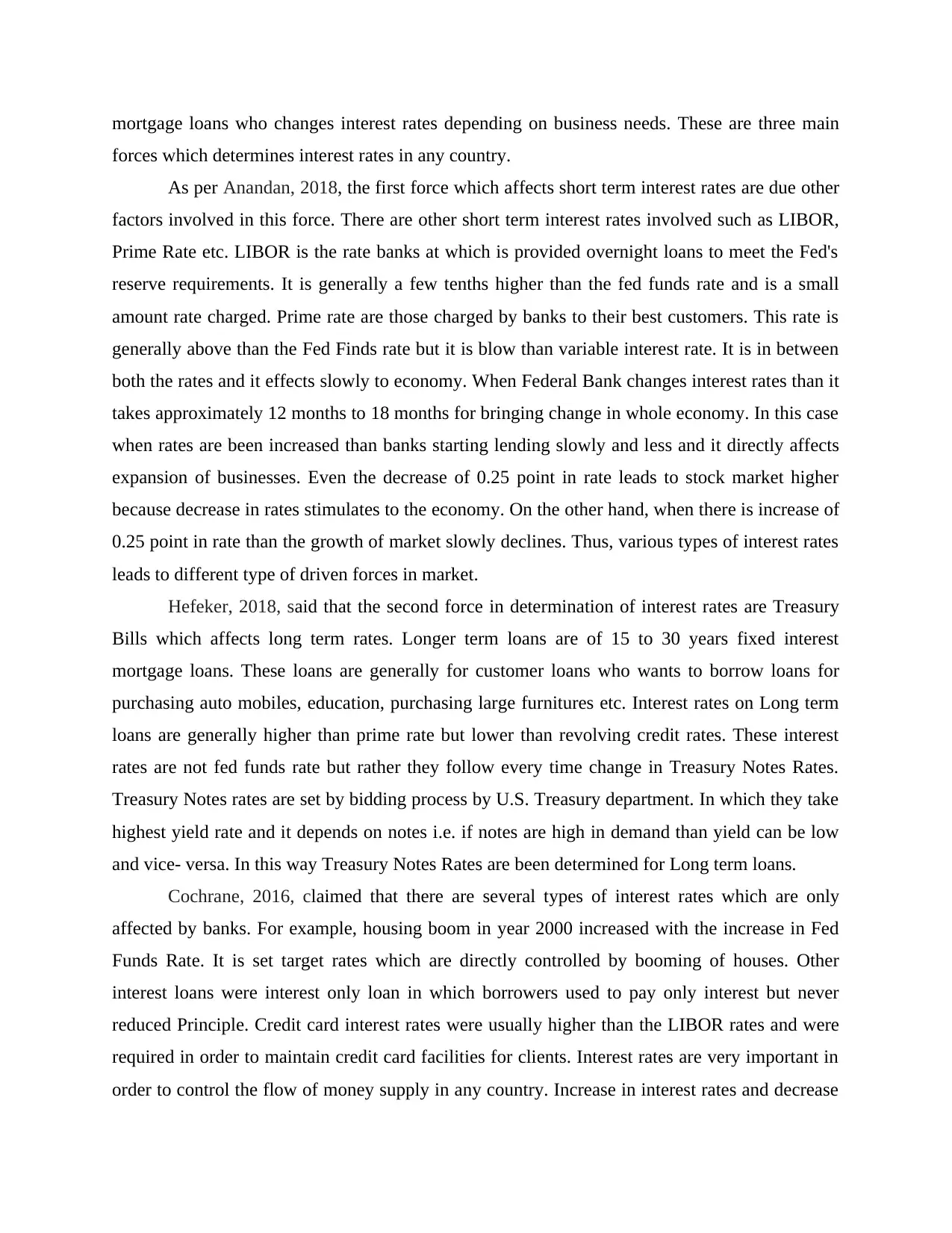
mortgage loans who changes interest rates depending on business needs. These are three main
forces which determines interest rates in any country.
As per Anandan, 2018, the first force which affects short term interest rates are due other
factors involved in this force. There are other short term interest rates involved such as LIBOR,
Prime Rate etc. LIBOR is the rate banks at which is provided overnight loans to meet the Fed's
reserve requirements. It is generally a few tenths higher than the fed funds rate and is a small
amount rate charged. Prime rate are those charged by banks to their best customers. This rate is
generally above than the Fed Finds rate but it is blow than variable interest rate. It is in between
both the rates and it effects slowly to economy. When Federal Bank changes interest rates than it
takes approximately 12 months to 18 months for bringing change in whole economy. In this case
when rates are been increased than banks starting lending slowly and less and it directly affects
expansion of businesses. Even the decrease of 0.25 point in rate leads to stock market higher
because decrease in rates stimulates to the economy. On the other hand, when there is increase of
0.25 point in rate than the growth of market slowly declines. Thus, various types of interest rates
leads to different type of driven forces in market.
Hefeker, 2018, said that the second force in determination of interest rates are Treasury
Bills which affects long term rates. Longer term loans are of 15 to 30 years fixed interest
mortgage loans. These loans are generally for customer loans who wants to borrow loans for
purchasing auto mobiles, education, purchasing large furnitures etc. Interest rates on Long term
loans are generally higher than prime rate but lower than revolving credit rates. These interest
rates are not fed funds rate but rather they follow every time change in Treasury Notes Rates.
Treasury Notes rates are set by bidding process by U.S. Treasury department. In which they take
highest yield rate and it depends on notes i.e. if notes are high in demand than yield can be low
and vice- versa. In this way Treasury Notes Rates are been determined for Long term loans.
Cochrane, 2016, claimed that there are several types of interest rates which are only
affected by banks. For example, housing boom in year 2000 increased with the increase in Fed
Funds Rate. It is set target rates which are directly controlled by booming of houses. Other
interest loans were interest only loan in which borrowers used to pay only interest but never
reduced Principle. Credit card interest rates were usually higher than the LIBOR rates and were
required in order to maintain credit card facilities for clients. Interest rates are very important in
order to control the flow of money supply in any country. Increase in interest rates and decrease
forces which determines interest rates in any country.
As per Anandan, 2018, the first force which affects short term interest rates are due other
factors involved in this force. There are other short term interest rates involved such as LIBOR,
Prime Rate etc. LIBOR is the rate banks at which is provided overnight loans to meet the Fed's
reserve requirements. It is generally a few tenths higher than the fed funds rate and is a small
amount rate charged. Prime rate are those charged by banks to their best customers. This rate is
generally above than the Fed Finds rate but it is blow than variable interest rate. It is in between
both the rates and it effects slowly to economy. When Federal Bank changes interest rates than it
takes approximately 12 months to 18 months for bringing change in whole economy. In this case
when rates are been increased than banks starting lending slowly and less and it directly affects
expansion of businesses. Even the decrease of 0.25 point in rate leads to stock market higher
because decrease in rates stimulates to the economy. On the other hand, when there is increase of
0.25 point in rate than the growth of market slowly declines. Thus, various types of interest rates
leads to different type of driven forces in market.
Hefeker, 2018, said that the second force in determination of interest rates are Treasury
Bills which affects long term rates. Longer term loans are of 15 to 30 years fixed interest
mortgage loans. These loans are generally for customer loans who wants to borrow loans for
purchasing auto mobiles, education, purchasing large furnitures etc. Interest rates on Long term
loans are generally higher than prime rate but lower than revolving credit rates. These interest
rates are not fed funds rate but rather they follow every time change in Treasury Notes Rates.
Treasury Notes rates are set by bidding process by U.S. Treasury department. In which they take
highest yield rate and it depends on notes i.e. if notes are high in demand than yield can be low
and vice- versa. In this way Treasury Notes Rates are been determined for Long term loans.
Cochrane, 2016, claimed that there are several types of interest rates which are only
affected by banks. For example, housing boom in year 2000 increased with the increase in Fed
Funds Rate. It is set target rates which are directly controlled by booming of houses. Other
interest loans were interest only loan in which borrowers used to pay only interest but never
reduced Principle. Credit card interest rates were usually higher than the LIBOR rates and were
required in order to maintain credit card facilities for clients. Interest rates are very important in
order to control the flow of money supply in any country. Increase in interest rates and decrease
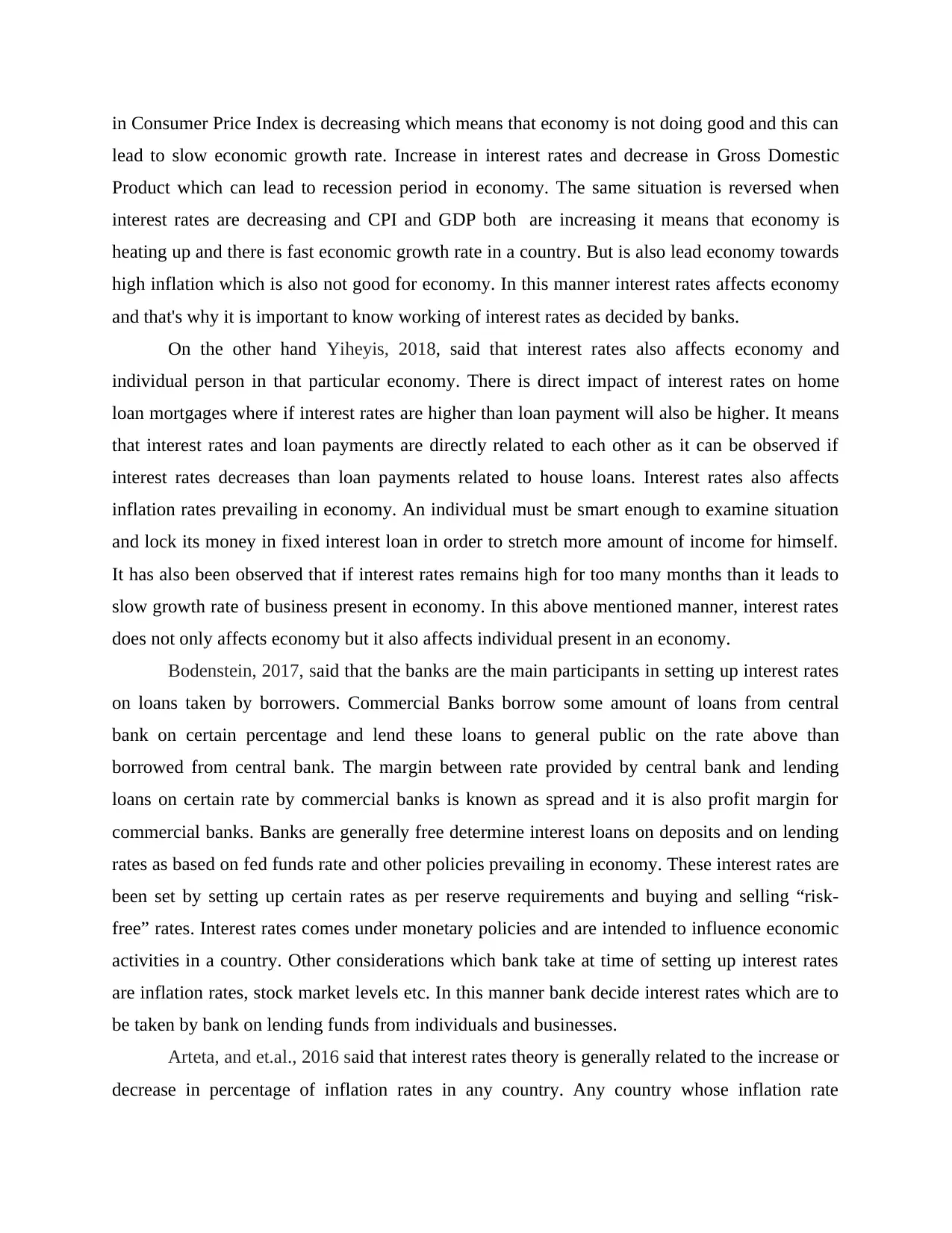
in Consumer Price Index is decreasing which means that economy is not doing good and this can
lead to slow economic growth rate. Increase in interest rates and decrease in Gross Domestic
Product which can lead to recession period in economy. The same situation is reversed when
interest rates are decreasing and CPI and GDP both are increasing it means that economy is
heating up and there is fast economic growth rate in a country. But is also lead economy towards
high inflation which is also not good for economy. In this manner interest rates affects economy
and that's why it is important to know working of interest rates as decided by banks.
On the other hand Yiheyis, 2018, said that interest rates also affects economy and
individual person in that particular economy. There is direct impact of interest rates on home
loan mortgages where if interest rates are higher than loan payment will also be higher. It means
that interest rates and loan payments are directly related to each other as it can be observed if
interest rates decreases than loan payments related to house loans. Interest rates also affects
inflation rates prevailing in economy. An individual must be smart enough to examine situation
and lock its money in fixed interest loan in order to stretch more amount of income for himself.
It has also been observed that if interest rates remains high for too many months than it leads to
slow growth rate of business present in economy. In this above mentioned manner, interest rates
does not only affects economy but it also affects individual present in an economy.
Bodenstein, 2017, said that the banks are the main participants in setting up interest rates
on loans taken by borrowers. Commercial Banks borrow some amount of loans from central
bank on certain percentage and lend these loans to general public on the rate above than
borrowed from central bank. The margin between rate provided by central bank and lending
loans on certain rate by commercial banks is known as spread and it is also profit margin for
commercial banks. Banks are generally free determine interest loans on deposits and on lending
rates as based on fed funds rate and other policies prevailing in economy. These interest rates are
been set by setting up certain rates as per reserve requirements and buying and selling “risk-
free” rates. Interest rates comes under monetary policies and are intended to influence economic
activities in a country. Other considerations which bank take at time of setting up interest rates
are inflation rates, stock market levels etc. In this manner bank decide interest rates which are to
be taken by bank on lending funds from individuals and businesses.
Arteta, and et.al., 2016 said that interest rates theory is generally related to the increase or
decrease in percentage of inflation rates in any country. Any country whose inflation rate
lead to slow economic growth rate. Increase in interest rates and decrease in Gross Domestic
Product which can lead to recession period in economy. The same situation is reversed when
interest rates are decreasing and CPI and GDP both are increasing it means that economy is
heating up and there is fast economic growth rate in a country. But is also lead economy towards
high inflation which is also not good for economy. In this manner interest rates affects economy
and that's why it is important to know working of interest rates as decided by banks.
On the other hand Yiheyis, 2018, said that interest rates also affects economy and
individual person in that particular economy. There is direct impact of interest rates on home
loan mortgages where if interest rates are higher than loan payment will also be higher. It means
that interest rates and loan payments are directly related to each other as it can be observed if
interest rates decreases than loan payments related to house loans. Interest rates also affects
inflation rates prevailing in economy. An individual must be smart enough to examine situation
and lock its money in fixed interest loan in order to stretch more amount of income for himself.
It has also been observed that if interest rates remains high for too many months than it leads to
slow growth rate of business present in economy. In this above mentioned manner, interest rates
does not only affects economy but it also affects individual present in an economy.
Bodenstein, 2017, said that the banks are the main participants in setting up interest rates
on loans taken by borrowers. Commercial Banks borrow some amount of loans from central
bank on certain percentage and lend these loans to general public on the rate above than
borrowed from central bank. The margin between rate provided by central bank and lending
loans on certain rate by commercial banks is known as spread and it is also profit margin for
commercial banks. Banks are generally free determine interest loans on deposits and on lending
rates as based on fed funds rate and other policies prevailing in economy. These interest rates are
been set by setting up certain rates as per reserve requirements and buying and selling “risk-
free” rates. Interest rates comes under monetary policies and are intended to influence economic
activities in a country. Other considerations which bank take at time of setting up interest rates
are inflation rates, stock market levels etc. In this manner bank decide interest rates which are to
be taken by bank on lending funds from individuals and businesses.
Arteta, and et.al., 2016 said that interest rates theory is generally related to the increase or
decrease in percentage of inflation rates in any country. Any country whose inflation rate
⊘ This is a preview!⊘
Do you want full access?
Subscribe today to unlock all pages.

Trusted by 1+ million students worldwide
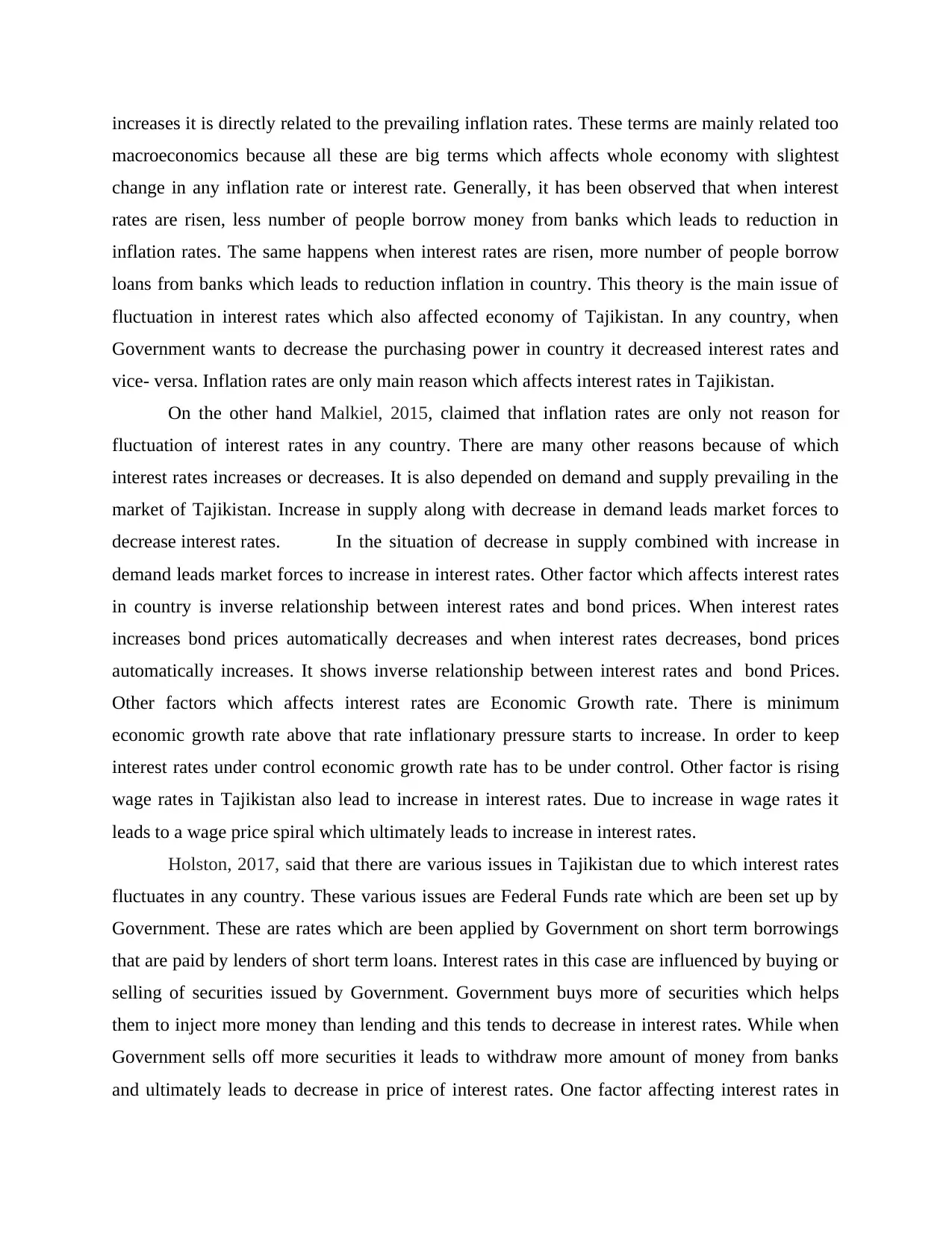
increases it is directly related to the prevailing inflation rates. These terms are mainly related too
macroeconomics because all these are big terms which affects whole economy with slightest
change in any inflation rate or interest rate. Generally, it has been observed that when interest
rates are risen, less number of people borrow money from banks which leads to reduction in
inflation rates. The same happens when interest rates are risen, more number of people borrow
loans from banks which leads to reduction inflation in country. This theory is the main issue of
fluctuation in interest rates which also affected economy of Tajikistan. In any country, when
Government wants to decrease the purchasing power in country it decreased interest rates and
vice- versa. Inflation rates are only main reason which affects interest rates in Tajikistan.
On the other hand Malkiel, 2015, claimed that inflation rates are only not reason for
fluctuation of interest rates in any country. There are many other reasons because of which
interest rates increases or decreases. It is also depended on demand and supply prevailing in the
market of Tajikistan. Increase in supply along with decrease in demand leads market forces to
decrease interest rates. In the situation of decrease in supply combined with increase in
demand leads market forces to increase in interest rates. Other factor which affects interest rates
in country is inverse relationship between interest rates and bond prices. When interest rates
increases bond prices automatically decreases and when interest rates decreases, bond prices
automatically increases. It shows inverse relationship between interest rates and bond Prices.
Other factors which affects interest rates are Economic Growth rate. There is minimum
economic growth rate above that rate inflationary pressure starts to increase. In order to keep
interest rates under control economic growth rate has to be under control. Other factor is rising
wage rates in Tajikistan also lead to increase in interest rates. Due to increase in wage rates it
leads to a wage price spiral which ultimately leads to increase in interest rates.
Holston, 2017, said that there are various issues in Tajikistan due to which interest rates
fluctuates in any country. These various issues are Federal Funds rate which are been set up by
Government. These are rates which are been applied by Government on short term borrowings
that are paid by lenders of short term loans. Interest rates in this case are influenced by buying or
selling of securities issued by Government. Government buys more of securities which helps
them to inject more money than lending and this tends to decrease in interest rates. While when
Government sells off more securities it leads to withdraw more amount of money from banks
and ultimately leads to decrease in price of interest rates. One factor affecting interest rates in
macroeconomics because all these are big terms which affects whole economy with slightest
change in any inflation rate or interest rate. Generally, it has been observed that when interest
rates are risen, less number of people borrow money from banks which leads to reduction in
inflation rates. The same happens when interest rates are risen, more number of people borrow
loans from banks which leads to reduction inflation in country. This theory is the main issue of
fluctuation in interest rates which also affected economy of Tajikistan. In any country, when
Government wants to decrease the purchasing power in country it decreased interest rates and
vice- versa. Inflation rates are only main reason which affects interest rates in Tajikistan.
On the other hand Malkiel, 2015, claimed that inflation rates are only not reason for
fluctuation of interest rates in any country. There are many other reasons because of which
interest rates increases or decreases. It is also depended on demand and supply prevailing in the
market of Tajikistan. Increase in supply along with decrease in demand leads market forces to
decrease interest rates. In the situation of decrease in supply combined with increase in
demand leads market forces to increase in interest rates. Other factor which affects interest rates
in country is inverse relationship between interest rates and bond prices. When interest rates
increases bond prices automatically decreases and when interest rates decreases, bond prices
automatically increases. It shows inverse relationship between interest rates and bond Prices.
Other factors which affects interest rates are Economic Growth rate. There is minimum
economic growth rate above that rate inflationary pressure starts to increase. In order to keep
interest rates under control economic growth rate has to be under control. Other factor is rising
wage rates in Tajikistan also lead to increase in interest rates. Due to increase in wage rates it
leads to a wage price spiral which ultimately leads to increase in interest rates.
Holston, 2017, said that there are various issues in Tajikistan due to which interest rates
fluctuates in any country. These various issues are Federal Funds rate which are been set up by
Government. These are rates which are been applied by Government on short term borrowings
that are paid by lenders of short term loans. Interest rates in this case are influenced by buying or
selling of securities issued by Government. Government buys more of securities which helps
them to inject more money than lending and this tends to decrease in interest rates. While when
Government sells off more securities it leads to withdraw more amount of money from banks
and ultimately leads to decrease in price of interest rates. One factor affecting interest rates in
Paraphrase This Document
Need a fresh take? Get an instant paraphrase of this document with our AI Paraphraser
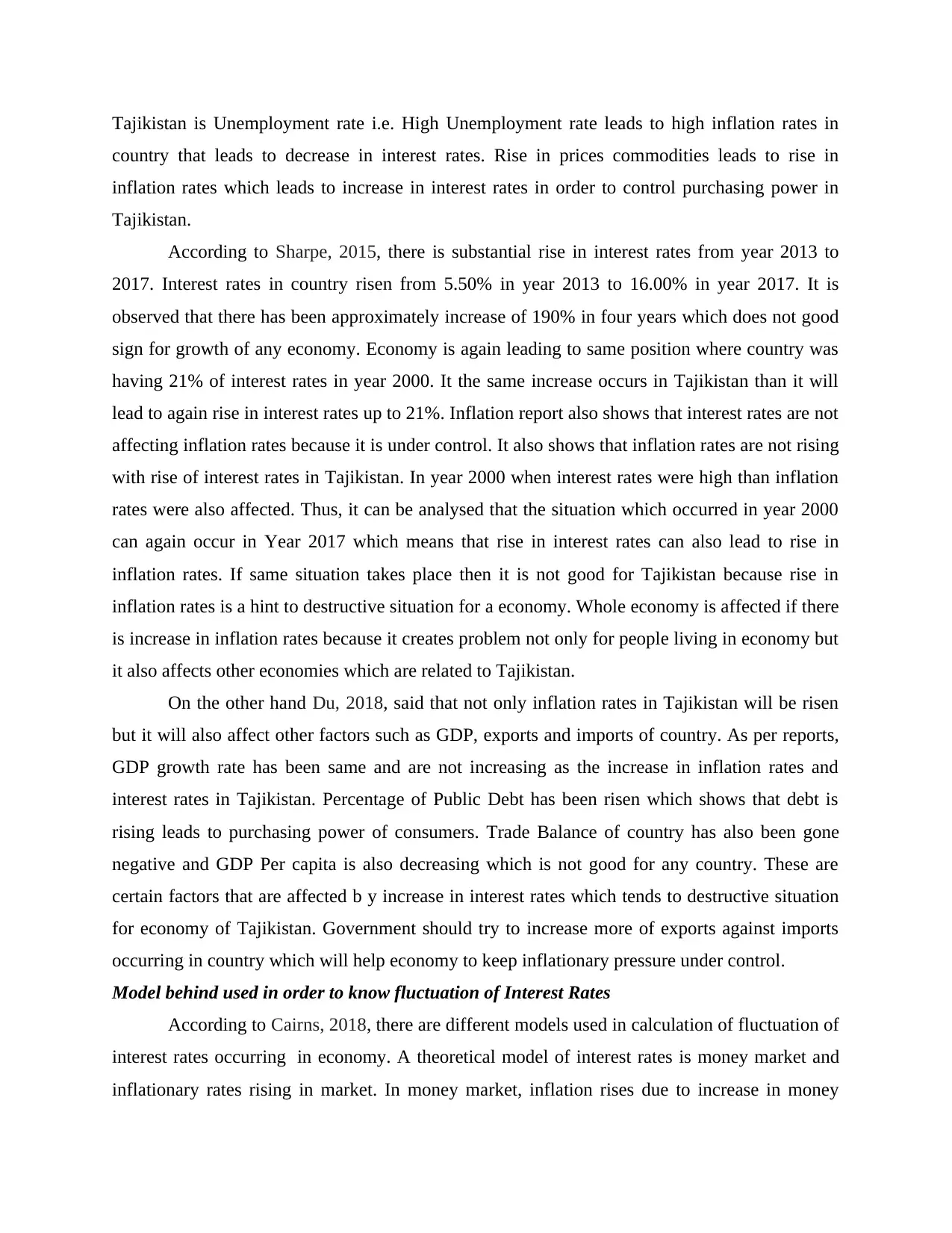
Tajikistan is Unemployment rate i.e. High Unemployment rate leads to high inflation rates in
country that leads to decrease in interest rates. Rise in prices commodities leads to rise in
inflation rates which leads to increase in interest rates in order to control purchasing power in
Tajikistan.
According to Sharpe, 2015, there is substantial rise in interest rates from year 2013 to
2017. Interest rates in country risen from 5.50% in year 2013 to 16.00% in year 2017. It is
observed that there has been approximately increase of 190% in four years which does not good
sign for growth of any economy. Economy is again leading to same position where country was
having 21% of interest rates in year 2000. It the same increase occurs in Tajikistan than it will
lead to again rise in interest rates up to 21%. Inflation report also shows that interest rates are not
affecting inflation rates because it is under control. It also shows that inflation rates are not rising
with rise of interest rates in Tajikistan. In year 2000 when interest rates were high than inflation
rates were also affected. Thus, it can be analysed that the situation which occurred in year 2000
can again occur in Year 2017 which means that rise in interest rates can also lead to rise in
inflation rates. If same situation takes place then it is not good for Tajikistan because rise in
inflation rates is a hint to destructive situation for a economy. Whole economy is affected if there
is increase in inflation rates because it creates problem not only for people living in economy but
it also affects other economies which are related to Tajikistan.
On the other hand Du, 2018, said that not only inflation rates in Tajikistan will be risen
but it will also affect other factors such as GDP, exports and imports of country. As per reports,
GDP growth rate has been same and are not increasing as the increase in inflation rates and
interest rates in Tajikistan. Percentage of Public Debt has been risen which shows that debt is
rising leads to purchasing power of consumers. Trade Balance of country has also been gone
negative and GDP Per capita is also decreasing which is not good for any country. These are
certain factors that are affected b y increase in interest rates which tends to destructive situation
for economy of Tajikistan. Government should try to increase more of exports against imports
occurring in country which will help economy to keep inflationary pressure under control.
Model behind used in order to know fluctuation of Interest Rates
According to Cairns, 2018, there are different models used in calculation of fluctuation of
interest rates occurring in economy. A theoretical model of interest rates is money market and
inflationary rates rising in market. In money market, inflation rises due to increase in money
country that leads to decrease in interest rates. Rise in prices commodities leads to rise in
inflation rates which leads to increase in interest rates in order to control purchasing power in
Tajikistan.
According to Sharpe, 2015, there is substantial rise in interest rates from year 2013 to
2017. Interest rates in country risen from 5.50% in year 2013 to 16.00% in year 2017. It is
observed that there has been approximately increase of 190% in four years which does not good
sign for growth of any economy. Economy is again leading to same position where country was
having 21% of interest rates in year 2000. It the same increase occurs in Tajikistan than it will
lead to again rise in interest rates up to 21%. Inflation report also shows that interest rates are not
affecting inflation rates because it is under control. It also shows that inflation rates are not rising
with rise of interest rates in Tajikistan. In year 2000 when interest rates were high than inflation
rates were also affected. Thus, it can be analysed that the situation which occurred in year 2000
can again occur in Year 2017 which means that rise in interest rates can also lead to rise in
inflation rates. If same situation takes place then it is not good for Tajikistan because rise in
inflation rates is a hint to destructive situation for a economy. Whole economy is affected if there
is increase in inflation rates because it creates problem not only for people living in economy but
it also affects other economies which are related to Tajikistan.
On the other hand Du, 2018, said that not only inflation rates in Tajikistan will be risen
but it will also affect other factors such as GDP, exports and imports of country. As per reports,
GDP growth rate has been same and are not increasing as the increase in inflation rates and
interest rates in Tajikistan. Percentage of Public Debt has been risen which shows that debt is
rising leads to purchasing power of consumers. Trade Balance of country has also been gone
negative and GDP Per capita is also decreasing which is not good for any country. These are
certain factors that are affected b y increase in interest rates which tends to destructive situation
for economy of Tajikistan. Government should try to increase more of exports against imports
occurring in country which will help economy to keep inflationary pressure under control.
Model behind used in order to know fluctuation of Interest Rates
According to Cairns, 2018, there are different models used in calculation of fluctuation of
interest rates occurring in economy. A theoretical model of interest rates is money market and
inflationary rates rising in market. In money market, inflation rises due to increase in money
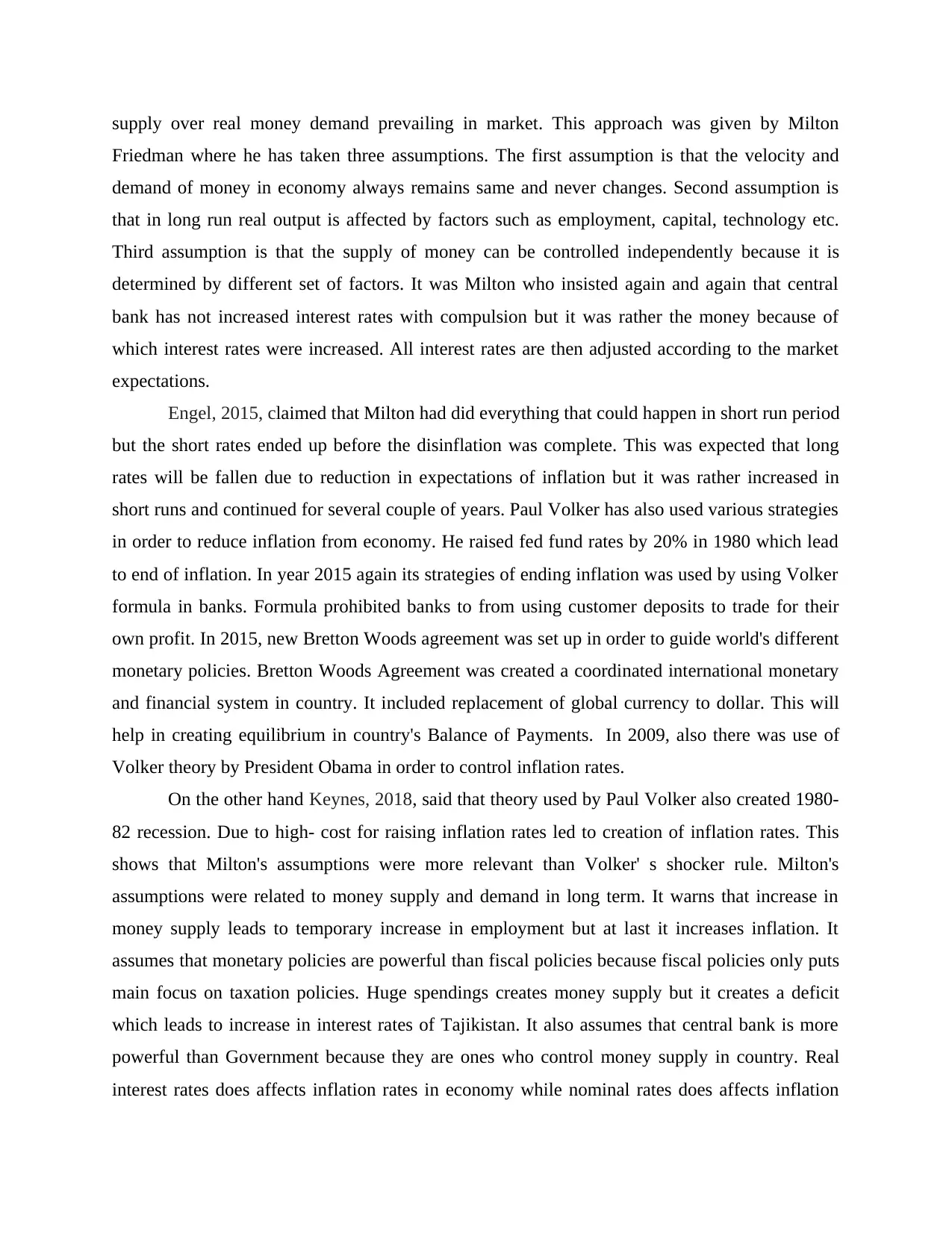
supply over real money demand prevailing in market. This approach was given by Milton
Friedman where he has taken three assumptions. The first assumption is that the velocity and
demand of money in economy always remains same and never changes. Second assumption is
that in long run real output is affected by factors such as employment, capital, technology etc.
Third assumption is that the supply of money can be controlled independently because it is
determined by different set of factors. It was Milton who insisted again and again that central
bank has not increased interest rates with compulsion but it was rather the money because of
which interest rates were increased. All interest rates are then adjusted according to the market
expectations.
Engel, 2015, claimed that Milton had did everything that could happen in short run period
but the short rates ended up before the disinflation was complete. This was expected that long
rates will be fallen due to reduction in expectations of inflation but it was rather increased in
short runs and continued for several couple of years. Paul Volker has also used various strategies
in order to reduce inflation from economy. He raised fed fund rates by 20% in 1980 which lead
to end of inflation. In year 2015 again its strategies of ending inflation was used by using Volker
formula in banks. Formula prohibited banks to from using customer deposits to trade for their
own profit. In 2015, new Bretton Woods agreement was set up in order to guide world's different
monetary policies. Bretton Woods Agreement was created a coordinated international monetary
and financial system in country. It included replacement of global currency to dollar. This will
help in creating equilibrium in country's Balance of Payments. In 2009, also there was use of
Volker theory by President Obama in order to control inflation rates.
On the other hand Keynes, 2018, said that theory used by Paul Volker also created 1980-
82 recession. Due to high- cost for raising inflation rates led to creation of inflation rates. This
shows that Milton's assumptions were more relevant than Volker' s shocker rule. Milton's
assumptions were related to money supply and demand in long term. It warns that increase in
money supply leads to temporary increase in employment but at last it increases inflation. It
assumes that monetary policies are powerful than fiscal policies because fiscal policies only puts
main focus on taxation policies. Huge spendings creates money supply but it creates a deficit
which leads to increase in interest rates of Tajikistan. It also assumes that central bank is more
powerful than Government because they are ones who control money supply in country. Real
interest rates does affects inflation rates in economy while nominal rates does affects inflation
Friedman where he has taken three assumptions. The first assumption is that the velocity and
demand of money in economy always remains same and never changes. Second assumption is
that in long run real output is affected by factors such as employment, capital, technology etc.
Third assumption is that the supply of money can be controlled independently because it is
determined by different set of factors. It was Milton who insisted again and again that central
bank has not increased interest rates with compulsion but it was rather the money because of
which interest rates were increased. All interest rates are then adjusted according to the market
expectations.
Engel, 2015, claimed that Milton had did everything that could happen in short run period
but the short rates ended up before the disinflation was complete. This was expected that long
rates will be fallen due to reduction in expectations of inflation but it was rather increased in
short runs and continued for several couple of years. Paul Volker has also used various strategies
in order to reduce inflation from economy. He raised fed fund rates by 20% in 1980 which lead
to end of inflation. In year 2015 again its strategies of ending inflation was used by using Volker
formula in banks. Formula prohibited banks to from using customer deposits to trade for their
own profit. In 2015, new Bretton Woods agreement was set up in order to guide world's different
monetary policies. Bretton Woods Agreement was created a coordinated international monetary
and financial system in country. It included replacement of global currency to dollar. This will
help in creating equilibrium in country's Balance of Payments. In 2009, also there was use of
Volker theory by President Obama in order to control inflation rates.
On the other hand Keynes, 2018, said that theory used by Paul Volker also created 1980-
82 recession. Due to high- cost for raising inflation rates led to creation of inflation rates. This
shows that Milton's assumptions were more relevant than Volker' s shocker rule. Milton's
assumptions were related to money supply and demand in long term. It warns that increase in
money supply leads to temporary increase in employment but at last it increases inflation. It
assumes that monetary policies are powerful than fiscal policies because fiscal policies only puts
main focus on taxation policies. Huge spendings creates money supply but it creates a deficit
which leads to increase in interest rates of Tajikistan. It also assumes that central bank is more
powerful than Government because they are ones who control money supply in country. Real
interest rates does affects inflation rates in economy while nominal rates does affects inflation
⊘ This is a preview!⊘
Do you want full access?
Subscribe today to unlock all pages.

Trusted by 1+ million students worldwide
1 out of 63
Related Documents
Your All-in-One AI-Powered Toolkit for Academic Success.
+13062052269
info@desklib.com
Available 24*7 on WhatsApp / Email
![[object Object]](/_next/static/media/star-bottom.7253800d.svg)
Unlock your academic potential
Copyright © 2020–2025 A2Z Services. All Rights Reserved. Developed and managed by ZUCOL.




